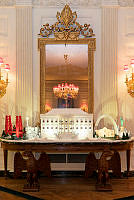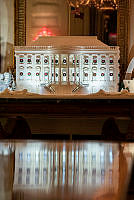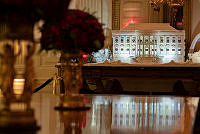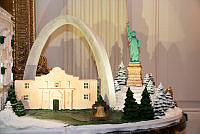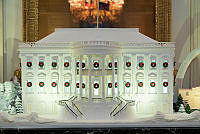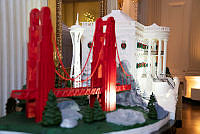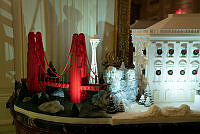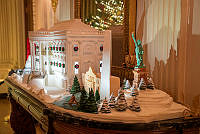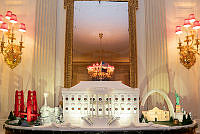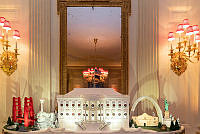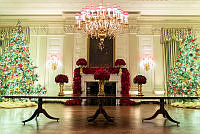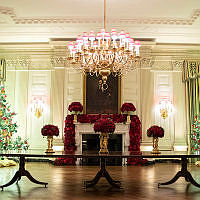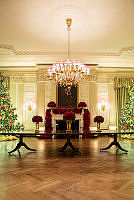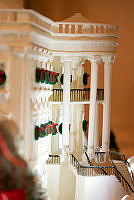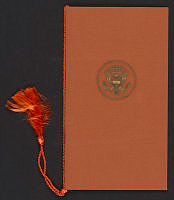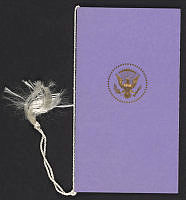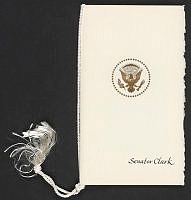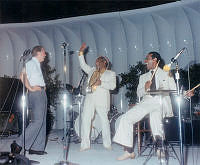Rubenstein Center Scholarship
Picketing the White House
The Suffragist Movement during the Great War
In the second half of the nineteenth century Americans headed west to seek greater opportunities for themselves and their families. As settlements and territories emerged, new residents actively participated in creating the political systems they lived under. In fact, it was in these sparsely populated areas that the women’s suffrage movement quickly gained momentum. Near the turn of the century, the territories of Wyoming, Utah, Washington, and Montana granted full voting rights to women. There were also a number of states that allowed women to vote prior to the ratification of the Nineteenth Amendment: Wyoming, Colorado, Utah, Idaho, Washington, California, Arizona, Kansas, Oregon, Montana, Nevada, New York, Michigan, Oklahoma, and South Dakota. Others such as Illinois, Nebraska, Ohio, Indiana, North Dakota, Rhode Island, Minnesota, Wisconsin, and Missouri permitted women to vote only for president before 1919. Needless to say, voting rights for women varied widely across the country. As more state legislatures granted these rights to female residents, suffragists launched a national campaign to persuade Congress to pass a constitutional amendment.1

Suffrage picketers marching along Pennsylvania Avenue on March 4, 1917.
Library of Congress/Records of the National Woman's PartyThe national struggle for women’s suffrage mobilized on March 3, 1913, the day before Woodrow Wilson’s inauguration in Washington, D.C. The National American Woman Suffrage Association (NAWSA), in collaboration with activists Alice Paul and Lucy Burns, organized a suffrage parade down Pennsylvania Avenue. The march began at the Peace Monument near the Capitol, passed alongside the White House, and ended with a rally at Memorial Continental Hall.2 Over 5,000 women marched for suffrage but their peaceful procession was disrupted by a “surging mass of humanity that completely defied the Washington police.” Army cavalry stationed at nearby Fort Myer restored order for the parading women. The suffragists were led by Grand Marshal of the procession May Jane Walker Burleson, “General” Rosalie Jones, Inez Milholland, and Dr. Anna Howard Shaw, president of NAWSA.3 The chaos prompted a Senate inquiry into the mishandling of the crowds. Legislators questioned policemen and their tactics, as wells as dozens of women who testified that they were insulted or injured by the throngs of people.4

On March 3, 1913, a women’s suffrage march was held in Washington D.C. Crowds gathered to watch but soon began to obstruct and stop the suffragists parading down Pennsylvania Avenue.
Library of CongressAfterwards suffrage leaders prepared the next phase of their campaign: persuade the president and secure his support for a constitutional amendment. Suffragists wasted little time, meeting with President Wilson just two weeks after he was sworn into office. Five women—Alice Paul, Anna Wiley, Edith Hooker, Ida Harper, and Genevieve Stone—gave the president a variety of reasons to back their cause. Harper even referenced Wilson’s 1912 campaign promise of “The New Freedom,” reasoning that a “perfect new freedom cannot come until women as well as men are given the right to vote.”5 The president, however, declined to commit, informing the women that the focus of his domestic policies would be tariff, banking, and business reforms. Undeterred, the suffragists continued to schedule meetings with President Wilson to discuss the right to vote over the next two years.6 Some were more spontaneous in nature, such as the delegation of 71 New Jersey women who marched on the White House and demanded an audience with the president in November 1913. The women insisted that the president publicly support a committee on women’s suffrage; Wilson assured his uninvited guests that such a committee was “under consideration,” but again refused to promise anything. After their exit the women marched on the United States Capitol to lobby New Jersey representatives for their cause. They even chased down Senator William Hughes, riding in an automobile on Pennsylvania Avenue, with “a parade of taxis.”7 At the NAWSA convention later that month, leaders unveiled a new “White House Campaign” strategy. Women were asked to join state committees and schedule frequent visits to the White House to remind the president of their mission.8

Men stopping to read anti-suffrage materials outside the National Association Opposed to Woman Suffrage Headquarters.
Library of CongressIn his first annual message to Congress, President Wilson failed to even mention the issue of women’s suffrage.9 A week later, Dr. Anna Shaw and her NAWSA delegation visited the White House again, pleading with Wilson to reconsider his priorities. The president demurred, explaining that his reluctance stemmed from his political belief that all three branches of government should remain independent and autonomous. While he expressed his support for a Congressional committee on women’s suffrage, Wilson explained that his private opinions were irrelevant to the legislative process.10 Without the president’s full support the suffragists faced political obstruction and denigration from anti-suffragist groups. During a suffrage parade on May 9, 1914, the National Association Opposed to Woman Suffrage encouraged its members to wear red roses on their clothing, hoping that these red flowers would ruin the color scheme of the suffrage banners and the appearance of female solidarity. Despite the rosy resistance, more than 5,000 women marched from the White House to the Capitol, demanding that Congress take up the issue of women’s suffrage. This time, local police authorities were prepared for the protest, ensuring that the women participating would “not be subjected to the indignities” they experienced during the 1913 march.11

Women protesting President Woodrow Wilson's position on suffrage in Chicago, Illinois in 1916.
Library of Congress/Records of the National Woman's PartyLater that summer “five hundred members of the General Federation of Women’s Clubs” called on President Wilson and were ushered into the East Room. When the president entered the room “there was no applause” to greet him, a gesture of dissent that many commentators later decried as disrespectful. Wilson permitted the leaders to air their grievances and afterwards he answered several questions raised by the suffragists. Wilson privately opposed women’s suffrage but evaded answering the question publicly. The suffragists pressed him to elaborate more on his private opinions; with no other recourse at hand, Wilson admitted that he believed women’s suffrage “is a matter for settlement by the States and not by the Federal government.” The public rebukes made by women leaders were quite extraordinary for their time. Lucy Burns, Vice Chairman of the Congressional Union, noted the irony: “For a disfranchised class seeking political freedom to be informed that they may not question the views of the ruler of their country on the matter of their own political status is really difficult to comprehend.” Alice Paul, Chairman of the Congressional Union for Woman Suffrage, responded by reminding women that Wilson had “put his party on record as refusing help to the suffrage cause. The several million enfranchised women cannot fail to remember this fact in deciding upon their party affiliations next November.”12 The confrontation between the president and the members of the women’s clubs also sparked conflict between suffragist groups as well. Dr. Anna Shaw of the NAWSA sent President Wilson a letter of apology, denouncing “any act in the name of woman suffrage which mars the record of dignity, lawfulness, and patriotism.”13 Disagreements over strategy grew over time, as the leaders of NAWSA continued to embrace a more moderate approach to suffrage while avoiding other contentious issues. The Congressional Union for Woman Suffrage (later the National Woman's Party) favored public actions that would draw attention to the movement while taking positions on other political and social issues.

Cameron House, ca. 1910. Situated on the east side of Lafayette Square, Cameron House served as the headquarters for the National Woman's Party until 1917. The party then moved across the park to 14 Jackson Place.
When meeting with the president failed to deliver concrete results, suffragists attempted another strategy: obtain closer proximity to the White House to protest and garner public support. NAWSA moved into its new national headquarters at 1626 Rhode Island Avenue, just six blocks north of the White House.14 Alice Paul and Lucy Burns’ Congressional Union for Woman Suffrage (now the National Woman’s Party) set up shop at Cameron House on the east side of Lafayette Square, a stone’s throw from the Executive Mansion. Inspired by the more extreme tactics of Emmeline Pankhurst and the British suffragette movement, members of the NWP attended President Wilson’s 1916 address to Congress. Sitting in the gallery of the House of Representatives, the women patiently waited until the president was speaking about the political rights of Puerto Rican citizens. On cue the women unfurled a suffragette banner inscribed with “great black letters: Mr. President, What Will You Do For Woman Suffrage?” The president gave a “suspicion of a smile” as he read their words, but quickly returned to his address.15

"Silent Sentinel" Alison Turnbull Hopkins stands guard near the White House on January 30, 1917.
Library of CongressSuffragists began their next campaign on January 10, 1917, when twelve "Silent Sentinels" picketed the White House gates to confront and shame the president for his inaction. This strategy continued even as the United States entered World War I on April 6, 1917. As part of the mobilization for war, government officials promoted national unity and industry; they also identified possible agitators and accused them of undermining the American war effort. The suffragists were no different. When asked whether her party followers were anarchists, Alice Paul replied, “It makes no difference to us what a woman’s political tendencies may be…We are working for a common cause—that of equal suffrage for women—and when we get the vote it is immaterial to us whether the women are Republicans, Democrats, Progressives, Socialists or anarchists. We have nothing to do with their politics.”16 NAWSA’s president Dr. Anna Howard Shaw was brought before the House committee on suffrage to answer allegations that the suffragists were “pro-German” and pacifists who “would welcome peace at any price.” Shaw pointed out that American women, including suffragists, were aiding the war effort both at home and abroad. When her colleague Mrs. Travis Whitney was asked about recent suffrage legislation passed in New York, one committee member insinuated that Socialist and pro-German sentiment made its success possible. Whitney retorted, “No political party, no class, no ‘isms,’ can lay exclusive claim to the suffrage victory. It was the people’s victory.”17

On October 20, 1917, the day after police announced that future picketers would receive a sentence of six months for unlawful protest, Alice Paul led the picket line. The banner reads, "The time has come to conquer or submit for there is but one choice—we have made it." This group would receive six months at Occoquan Workhouse for their protest.
Library of CongressAs the country prepared for war, tensions and conflict emerged between different groups of Americans. Many government officials and citizens interpreted wartime protests as public acts of disloyalty; as such, both authorities and crowds directed their anger toward any dissidents. As the “Silent Sentinels” picketed the White House during the summer of 1917, White House policemen continuously arrested the suffragists on charges of unlawful assembly, disorderly conduct, and disrupting traffic. Suffragists were fined but they generally refused to pay out of protest. As their actions became more disruptive, authorities levied harsher sentences, sending the picketers to Occoquan Workhouse and Penitentiary in Lorton, Virginia. Masses appeared to watch the women demonstrate, though these spectators were not always peaceful themselves. Some incited violence by accosting the women and destroying their banners. In one instance, a group vandalized the NWP headquarters with “eggs, tomatoes, missiles of various sorts.”18
As this neighborhood melee unfolded, President Wilson began to soften his stance on women’s suffrage. Perhaps it was the president’s daughter, Jessie Woodrow Wilson Sayre, who persuaded her father to soften his stance - though the more likely explanation was that Wilson realized this anti-suffrage position would cost the Democratic Party seats in Congress.19 That fall he expressed verbal support for the suffrage campaign in New York, but ultimately the reports of how suffragists were mistreated in Occoquan convinced Wilson to intervene on moral grounds. One Washington Post story described how Alice Paul, recently sentenced to six months in a workhouse for picketing, was subjected to physical and mental examinations by five physicians against her will. When Paul started a hunger strike out of protest at the District workhouse she was “forcibly fed twice…through a tube.”20 Several days after the printing of Paul’s experience, the "Night of Terror" took place on November 14. The 33 suffragists imprisoned at Occoquan were “brutally handled by the guards and subjected to indignities” for refusing to work or eat. In obtaining a writ of habeas corpus for the women, NWP counsel Dudley Field Malone argued that the women “were being subjected to cruel and unusual punishment,” citing Lucy Burns’ diary and their injuries as proof.21 The reports of abuse appalled President Wilson, prompting him to immediately pardon the prisoners and join the suffrage crusade.
The least tribute we can pay them is to make them the equals of men in political rights as they have proved themselves their equals in every field of practical work they have entered, whether for themselves or for their country.
In December 1917 the president forcefully advocated for women’s suffrage in his sixth annual address to Congress, arguing that women had earned the right to vote by performing traditional duties while bearing the burden of new wartime responsibilities. “The least tribute we can pay them is to make them the equals of men in political rights as they have proved themselves their equals in every field of practical work they have entered, whether for themselves or for their country,” articulated Wilson. “These great days of completed achievement would be sadly marred were we to omit that act of justice.”22 Nearly a month later, President Wilson delivered his famous “Fourteen Points” speech to Congress on January 8, 1918. The president outlined his vision for a new world order built on the American ideals of democracy and freedom. At a White House conference the next day, Wilson stunned everyone by publicly declaring his support for a women’s suffrage constitutional amendment.23 In November, the news of an armistice sparked celebration for many Americans. The influx of U.S. troops, war materials, and monetary credit gave the Allied Powers much needed momentum to break the stalemate. American mobilization efforts had saved Western Europe and established the United States as a formidable global power.

Alice Paul, Chairman of the National Woman's Party, unfurls the ratification banner at the 14 Jackson Place headquarters on August 18, 1920. Tennessee became the 36th state to ratify the amendment, reaching the 3/4 threshold to officially make the 19th Amendment part of the United States Constitution.
National Woman's Party at the Belmont-Paul Womens Equality National MonumentWilson’s policy reversal did little to appease suffragists. They continued to picket the Executive Mansion and hold public burnings of any speech where Wilson mentioned the words ‘democracy’ and ‘freedom.’ After the Senate initially failed to pass the amendment in early 1919, suffrage supporters ramped up public protests and demonstrations. Their persistent pressure on the president and the incoming Congress produced political results later that spring. On May 21, 1919 the Susan B. Anthony Amendment passed 304-89 in the House of Representatives; on June 4 it cleared the Senate by a vote of 56-25.24 In order for the amendment to become law, three-fourths of the states needed to ratify it. Suffragists shifted attention back to their respective states, petitioning their representatives relentlessly for the next year. On August 18, 1920, Tennessee became the 36th state to ratify the 19th Amendment.25 Alice Paul, who suffered appalling treatment at Occoquan, celebrated the news by unfurling a massive ratification banner at 14 Jackson Place. The banner, decorated with 36 stars, each representing a state that had approved the Nineteenth Amendment, symbolized the national and state-level successes achieved by the suffragists. While some of their tactics were considered radical for the time, suffragists persevered by demonstrating their willingness to fight for equality. Their struggles—with members of Congress, angry crowds, policemen and guards, anti-suffragists, and President Wilson himself—gave momentum to the movement, drawing more supporters to their cause. The gross mistreatment of suffragists gave them a moral high ground, one that President Wilson eventually felt compelled to join. As the United States projected the merits of democracy abroad, its representatives now answered to citizens, both male and female, at home.




